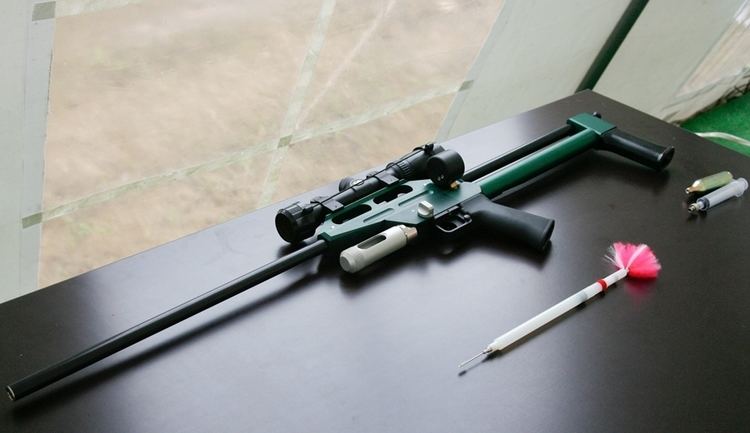 | ||
A tranquillizer gun (also spelled tranquilizer gun or tranquilliser gun), capture gun or dart gun, is a non-lethal air gun often used for incapacitating animal targets via projectile injection of anesthetic chemicals usually referred as tranquilizers. These guns shoot darts with a hypodermic needle tip, filled with a dose of tranquilizer solution that is either sedative, comatosing or paralytic, which once injected will temporarily impair the target's physical function to a level that allows it to be approached and handled in an unresisting and thus safe manner. Tranquillizer guns have a long history of use to capture wildlife without risking serious injuries to both the hunter and the target. Tranquillizer darts can also be fired by crossbow or breath-powered blowgun.
Contents
History
For thousands of years various tribal peoples have used poisoned arrows (for example tipped with Curare), to incapacitate animals before killing them, but the modern tranquillizer gun was invented only in the 1950s by New Zealander Colin Murdoch. While working with colleagues who were studying introduced wild goat and deer populations in New Zealand, Murdoch had the idea that the animals would be much easier to catch, examine, and release if a dose of tranquillizer could be administered by projection from afar. Murdoch went on to develop a range of rifles, darts, and pistols that have had an enormous impact on the treatment and study of animals around the world.
The first remote drug delivery system was actually invented by scientists at the University of Georgia in the 1950s, and was the direct predecessor to the Cap-Chur equipment used worldwide for decades.
In Kenya in the early 1960s, a team headed by Dr. Tony Pooley and Dr. Toni Harthoorn discovered that various species, despite being of roughly equal size (for example, the rhinoceros and the buffalo), needed very different doses and spectra of drugs to safely immobilize them.
Characteristics
The dart, usually .50 caliber (12.7 mm), is essentially a ballistic syringe loaded with an immobilizing drug and hypodermic needle, is propelled from the gun by means of compressed gas. In flight, the dart is stabilized by a tailpiece, a tuft of fibrous material, making it behave somewhat like a badminton shuttlecock. The same syringe design may be used interchangeably in certain blowguns. The needle may be plain, or collared; a collared needle has a barb-like circumferential ring that improves retention of the needle and syringe for recovery and to assure that the full dose is administered.
On impact with the animal, the momentum of a steel ball at the rear of the dart pushes the syringe plunger and intramuscularly injects a dose of barbiturate or other sedative drugs into the animal. The tranquilizer drug causes the target to become sleepy and suddenly unconscious within 45 minutes. Because of the power of the drugs, the handlers then have to move quickly to secure the animal for transport, monitor its vital signs, protect its eyes and ears, and then inject antidotes when needed. Many large animals are acutely sensitive to stress and can easily die without careful treatment; in order to counter stress in targeted animals, the gun is quiet, and there is usually a valve on the gun to control the dart velocity.
Agents
Several immobilizing drugs have been devised for use in tranquillizer darts. These include:
Military and police use
Tranquillizer darts are not generally included in military or police less-than-lethal arsenals because no drug is yet known that would be quickly and reliably effective on humans without the risks of side effects or an overdose. This means that effective use requires an estimate of the weight of the target to be able to determine how many darts (if any) can be used. Shooting too few would result in partial effects only, while too many can kill the target. According to James Butts, former Chief of Police of Santa Monica, "Tranquilizing agents don't affect everyone uniformly. Therefore you cannot predict whether or not you have a sufficient dose to tranquilize the individual. Second, any tranquillizer will take time to enter the bloodstream and sedate the individual. If someone is advancing on you with a deadly weapon or a threatening object, there's no way a tranquillizer would take effect in the two to three seconds it would take someone to seriously injure you."
